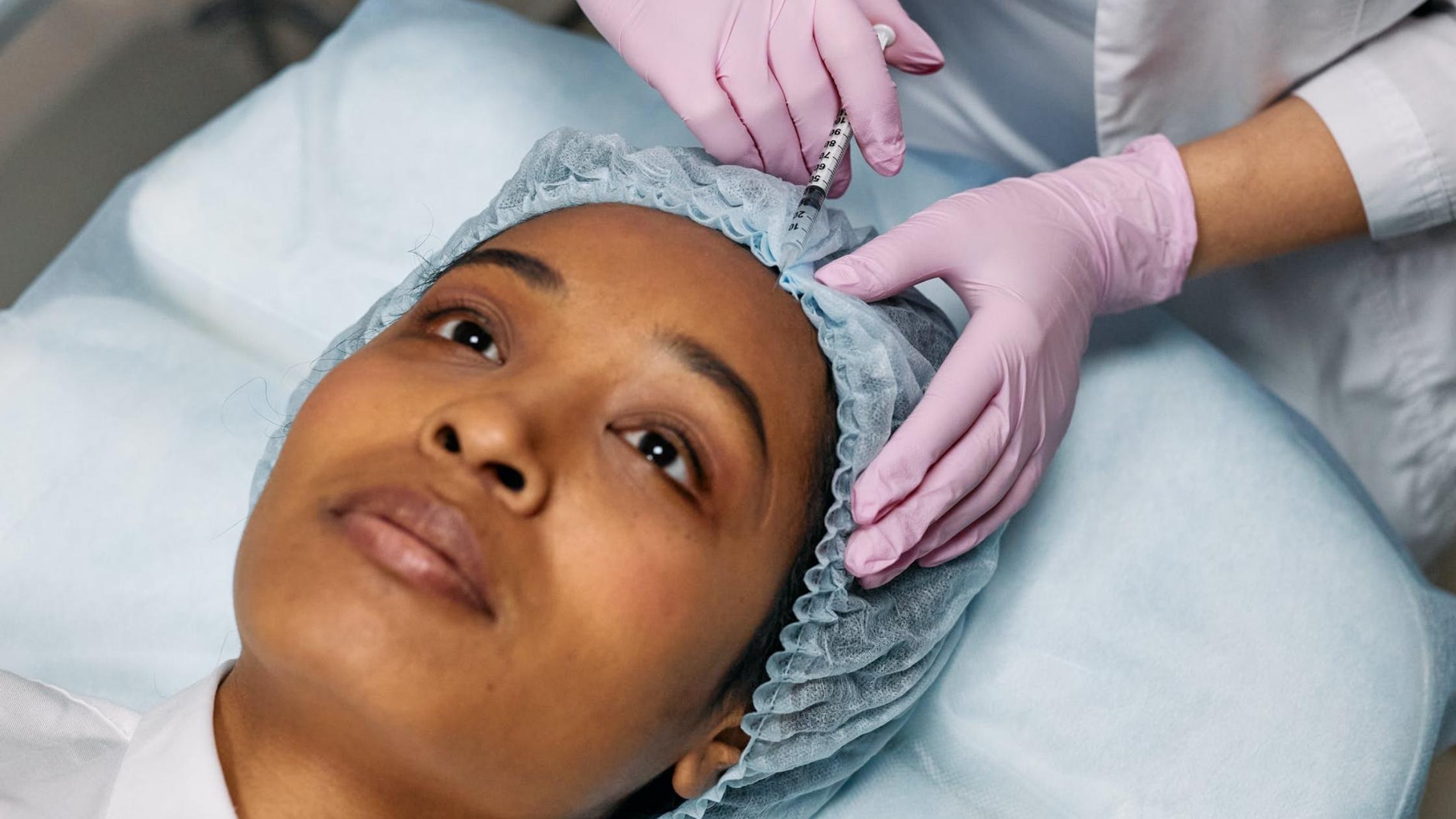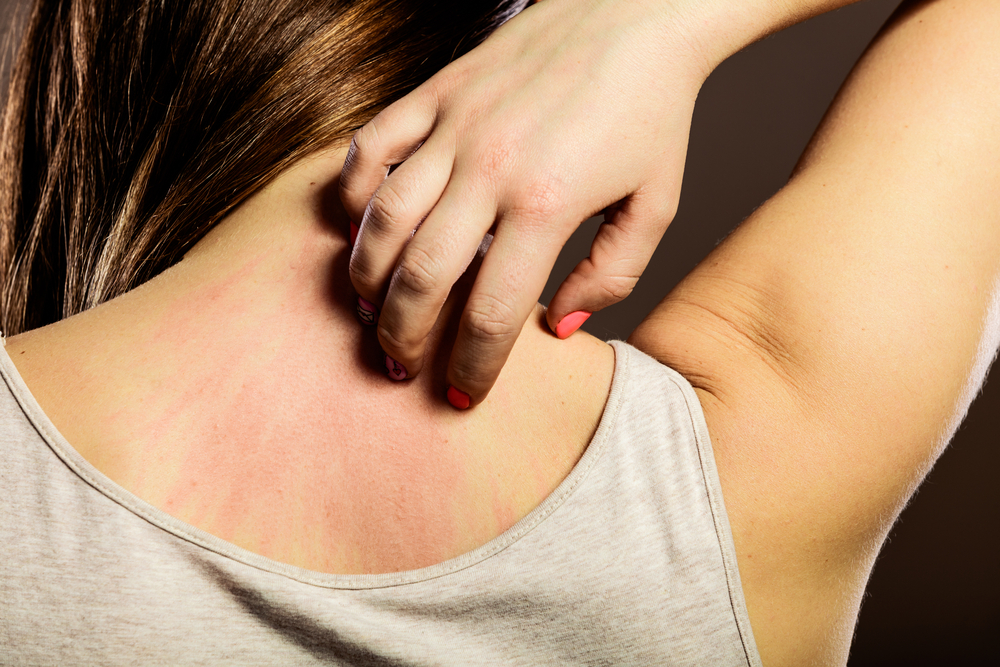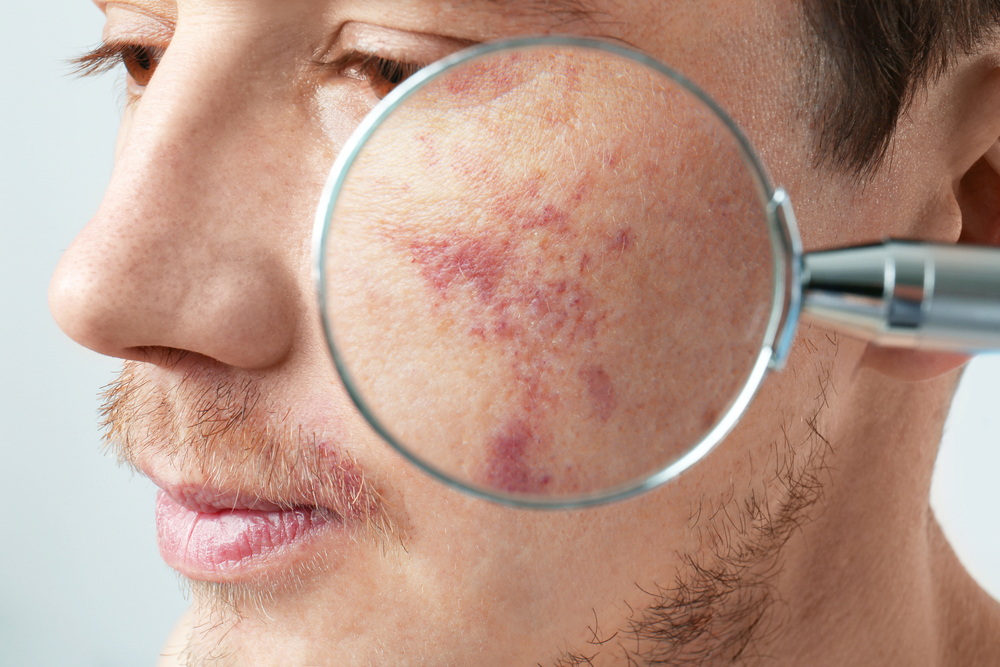- Sun allergy actually encompasses a number of conditions that can result in an itchy red rash following exposure to sunlight.
- The most common form of sun allergy is called polymorphic light eruption or PMLE.
- Mild cases may clear up without treatment.
Not all skin reactions to the sun are true allergies. A sun allergy – like other allergies – is an immune system reaction. However, instead of a reaction to food or pollen, it’s a reaction to sunlight.
Ultraviolet rays activate the body’s natural defense mechanism against sun-exposed skin. This allergic reaction results in an itchy red rash, tiny blisters or hives. A sun allergy is a type of photodermatosis. ‘Photo’ means light, ‘derm’ means skin, and ‘tosis’ means condition. There are over 20 different types of photodermatoses, ranging from mild to severe.
A photodermatosis or sun allergy can be confused with sunburn, eczema or other skin conditions. It commonly occurs in areas of the body that get a lot of direct sunlight, like the upper chest and outer arms. A 2011 German study suggests that 1 out of every 5 people in Europe and North America may experience a common form of sun allergy known as polymorphous light eruption or PMLE.
Risk Factors
Risk factors for sun allergy include:
- Race — The most common type of sun allergy (polymorphic light eruption or PMLE) occurs mostly in Caucasians. A hereditary form of PMLE is common in people of Native American ancestry.
- Having relatives with a sun allergy — People with a parent or sibling with sun allergy are also more likely to develop it.
- Taking certain medications — A number of medications can make the skin more sensitive to sun, like sulfa-based drugs, certain diabetes medications, certain nonsteroidal anti-inflammatory drugs or pain relievers, certain migraine medications, certain diuretics as well as tetracycline antibiotics.
- Exposure to skin irritants — May include perfumes, detergents, disinfectants and even certain compounds found in sunscreens.
- Having another skin condition — Having a pre-existing condition, like dermatitis or eczema, can increase risk.
Top Types of Photodermatoses
Only certain people develop a sun allergy, especially those who have a parent or sibling with the condition. There are several different categories of sun allergy. These are a few of the most common types.
Polymorphous light eruption (PMLE)
The most common type of photodermatosis is called ‘polymorphous’ because it can take any form. Its appearance on the skin varies from person to person.
After sunburns, PMLE is one of the most common sun-related skin problems seen by doctors. It usually manifests as an itchy rash on sun-exposed skin and affects people of all races and ethnic backgrounds but occurs more often in women than men. The condition typically begins in young adulthood. In geographic areas with colder winter climates, PMLE is more common during spring and summer.
- Symptoms — Raised, red, itchy patches, most commonly appearing in places that get the most direct sunlight (upper chest, upper arms, thighs and backs of hand). This can develop in a matter of hours or only show a few days after sun exposure. A severe hereditary form of PMLE more common in people of Native American descent often involves a rash around the mouth.
- Treatment — The skin rash or ‘light eruption’ usually disappears on its own within several days and does not leave any scars or marks. PMLE is not considered life-threatening. For mild symptoms, simply applying cool, damp washcloths on the affected areas can offer relief. You can also try over-the-counter oral antihistamines to help with itching or apply non-prescription-strength cream containing cortisone on the rash. For more serious or chronic symptoms, a doctor may need to prescribe stronger oral antihistamine, corticosteroid cream or treatment with phototherapy.
- Hardening — People with PMLE in temperate climates may notice that symptoms are worse in early spring and gradually disappear over the summer as the skin gets used to repeated sun exposure. This process is called ‘hardening’ as the skin becomes less sensitive to sunlight. If the hardening process does not happen naturally, a doctor may prescribe phototherapy, a treatment involving regular doses of ultraviolet light on the skin to produce hardening.
Photoallergic Eruption
This type of sun allergy is caused by medication, ointment, sunscreen, perfume, cosmetics or other substances either taken orally or applied directly to the skin.
- Symptoms — Itchy red rash or tiny blisters that may spread to skin that was covered by clothing and not exposed directly to sunlight. Symptoms may only occur one or two days following sun exposure as the underlying mechanism is a delayed hypersensitivity reaction.
- Diagnosis — Figuring out the cause of a photoallergic eruption may require some testing by a specialist. Your doctor may suggest switching certain medications or stopping particular skin products to see if symptoms resolve. Otherwise, you may get referred to a dermatologist for photopatch testing. This procedure exposes a small area of skin to a combination of a test chemical and ultraviolet light to identify the trigger.
- Treatment — Identify and stop using the medication or product that triggers the sun allergy. If symptoms persist, photoallergic eruption can be treated with a corticosteroid cream until the true culprit is identified.
Solar Urticaria
Solar urticaria is a rare condition that usually affects young women. ‘Urticaria’ is the medical word for ‘hives.’ Like other allergic reactions that cause hives, symptoms can escalate to a deadly reaction throughout the body known as anaphylaxis, which requires prompt medical attention.
- Symptoms — Large, itchy, red bumps or hives on skin after minutes of being exposed to sunlight. Hives usually fade on their own an hour or two following sun exposure.
- Diagnosis — A doctor may confirm the diagnosis by photo-testing a patch of skin in the office, using a special ultraviolet lamp to reproduce the hives.
- Treatment — Identify and stop using the medication or product that triggers the sun allergy. For mild hives, try the same symptom-management as PMLE. Over-the-counter oral antihistamines or anti-itch creams containing cortisone may also work. If not, a doctor can prescribe stronger antihistamines and creams.
Cholinergic Urticaria or “Heat Rash”
This is another condition that results in ‘hives’ or raised red itchy patches on the skin, caused by an increase in body temperature. It can be triggered by exposure to sunlight but also hot showers, exercise or even spicy foods. Treatment is usually with oral antihistamines.
When to Use Home Remedies and When to Consult an MD
More serious cases of sun allergy may be treated with steroid creams or pills, which can help bring down swelling. Unfortunately, steroids can have a number of side effects and so should only be used sparingly as needed and as prescribed.
For mild sun allergy, the rash may clear up on its own without any treatment. Home remedies like calamine lotion or aloe vera can help soothe the skin, especially if it is inflamed and itchy. Pain can be treated with over-the-counter ibuprofen or another nonsteroidal anti-inflammatory drug. Severe or stubborn sun allergy may warrant a visit to the dermatologist.
For severe cases of sun allergy, especially in temperate climates where the body gets ‘sunlight shock’ every spring, doctors may suggest phototherapy with a special ultraviolet lamp to get the skin used to sunlight in the spring. Phototherapy usually lasts several weeks and prepares the skin for exposure to sunlight.
If any case of sun allergy is accompanied by fever, swelling, increased or irregular heartbeat, dizziness, nausea, vomiting, or confusion, call 911 or seek immediate medical attention. These symptoms could be a sign of anaphylaxis, the most dangerous of all allergic reactions. It involves multiple body systems and requires quick treatment or it could be life-threatening.
Blocking out Sun Allergies
Dr. Bruce Katz, a board-certified dermatologist and director of JUVA Skin & Laser Center in New York City, says, “When patients get a rash from sun exposure, the only way to prevent these rashes is to avoid the sun, wear sunscreens and cover up.”
People who are sensitive to the sun can take the following steps to protect their skin:
- Limit sun exposure, especially during peak times. Find shade or stay indoors when the sun is at its brightest (between noon and 4 p.m.). Most symptoms of sun allergy resolve quickly – within hours or a few days once the affected area is no longer exposed to the sun.
- Wear hats, sunglasses and protective clothing. Hats with wide brims can shade the face, neck and upper chest. Long-sleeved shirts or clothes specially designed to block UV rays can help prevent sun allergy.
- Be aware of medications and skin care products that increase light sensitivity. Check with your doctor whether certain medications could trigger sun allergy. These can include certain antibiotics, blood pressure medicines, oral birth control pills and antidepressants.
- Use a broad-spectrum sunscreen (SPF 15 or higher). Reapply every two hours or as recommended. In some instances, sunscreen can actually worsen photodermatoses so in these cases, protective clothing or sun avoidance are preferable.









